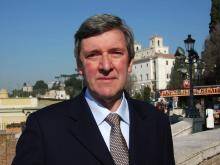The publication of the encyclical “Laudato Si’” revealed two small but significant ways in which the Argentine pope has sought to develop collegiality. First, he drew on input from at least 16 bishops’ conferences when writing the encyclical. Second, he sent a copy of the text to every diocesan bishop two days before its publication, accompanied by a personal handwritten note. He hoped they would rise to the occasion by participating in his universal magisterium.
That handwritten note in Italian, accompanied by a translation in the relevant languages, was particularly significant since it contained an explicit reference to No. 22 of Vatican II’s “Dogmatic Constitution on the Church,” which speaks about collegiality. The note read:
JHS. The Vatican, 16 June 2015. Dear brother, In the bond of unity, charity and peace (LG 22) in which we live as bishops, I send you my letter “Laudato Si’ on Care of our Common Home,” accompanied by my blessing. United in the Lord, and please do not forget to pray for me.
-Franciscus
To understand Pope Francis’ determination to foster and develop collegiality in the church, it is necessary to remember that he served as a diocesan bishop for 21 years (1992–2013) before his election to the See of Peter, first as an auxiliary bishop, then as coadjutor and finally archbishop of Buenos Aires.
Several popes have been diocesan bishops, but Francis is the first pope ever to have served as president of a national bishops’ conference. He was elected to head the Argentine bishops’ conference for two terms (2006–12). He is also the first pope to have played a key role in a plenary assembly of a continental conference of bishops, the Conference of Latin American Bishops (CELAM). In that capacity he was elected at its plenary assembly in Aparecida, Brazil, in 2007—almost unanimously—to chair the all-important committee assigned to draft its final document. In addition to all this, he participated in several synods of bishops and was appointed to the key role of rapporteur (relator) at the September 2001 synod, replacing Cardinal Edward Egan of New York, who had to return home suddenly after the terrorist attack on the World Trade Center. His skillful performance at that global event caused many cardinals to view him as a potential successor to St. John Paul II.
It should also be remembered that in these various roles, especially as president of the Argentine bishops’ conference, Bergoglio experienced first hand and on several occasions tensions and incomprehension between the center and the periphery. He came to understand that there could be a better way of doing things if collegiality and synodality were allowed to flourish.
Since becoming pope, he has sought to make this happen in several ways, and in his programmatic document “The Joy of the Gospel” he identified the development of collegiality and synodality as one of the goals of his pontificate (No. 32). He has reaffirmed that aim on a number of occasions since then.
In pursuit of that objective, he has established the Council of Cardinal Advisors, increased the number of cardinals and bishops on the boards of the different Vatican congregations and offices, pioneered a new way of conducting the synod of bishops and participated actively in the work of the synod’s council. Furthermore, he has sought to internationalize even more the College of Cardinals by appointing members from the peripheries. And he has decentralized the presentation of the pallium to new archbishops so as to involve the local church.
Moving away from a monarchical style of papacy, he has made clear that national bishops’ conferences should be the ones to comment on major issues in their countries, and not the pope. This explains his silence when civil authorities in various countries, including the United States, approved same-sex marriage.








